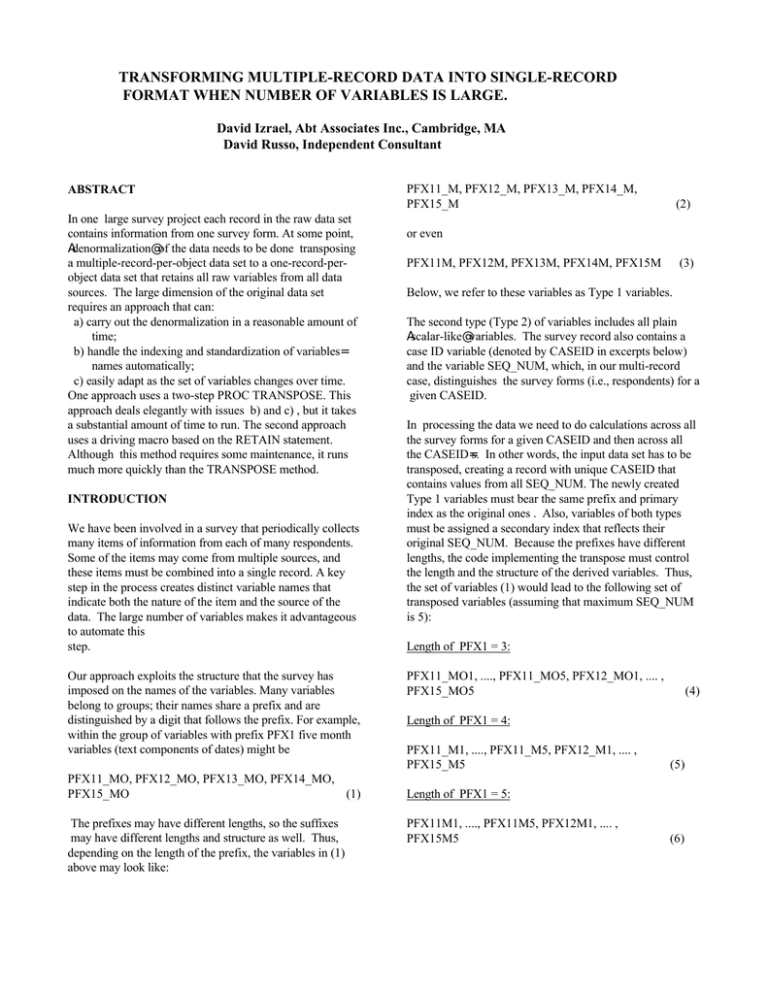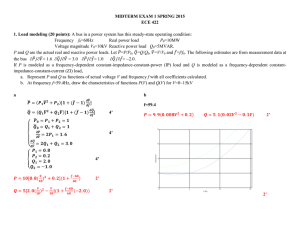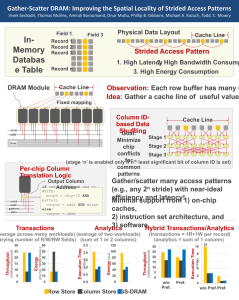Transforming Multiple-Record Data into Single
advertisement

TRANSFORMING MULTIPLE-RECORD DATA INTO SINGLE-RECORD
FORMAT WHEN NUMBER OF VARIABLES IS LARGE.
David Izrael, Abt Associates Inc., Cambridge, MA
David Russo, Independent Consultant
ABSTRACT
In one large survey project each record in the raw data set
contains information from one survey form. At some point,
Adenormalization@ of the data needs to be done transposing
a multiple-record-per-object data set to a one-record-perobject data set that retains all raw variables from all data
sources. The large dimension of the original data set
requires an approach that can:
a) carry out the denormalization in a reasonable amount of
time;
b) handle the indexing and standardization of variables=
names automatically;
c) easily adapt as the set of variables changes over time.
One approach uses a two-step PROC TRANSPOSE. This
approach deals elegantly with issues b) and c) , but it takes
a substantial amount of time to run. The second approach
uses a driving macro based on the RETAIN statement.
Although this method requires some maintenance, it runs
much more quickly than the TRANSPOSE method.
INTRODUCTION
We have been involved in a survey that periodically collects
many items of information from each of many respondents.
Some of the items may come from multiple sources, and
these items must be combined into a single record. A key
step in the process creates distinct variable names that
indicate both the nature of the item and the source of the
data. The large number of variables makes it advantageous
to automate this
step.
Our approach exploits the structure that the survey has
imposed on the names of the variables. Many variables
belong to groups; their names share a prefix and are
distinguished by a digit that follows the prefix. For example,
within the group of variables with prefix PFX1 five month
variables (text components of dates) might be
PFX11_MO, PFX12_MO, PFX13_MO, PFX14_MO,
PFX15_MO
(1)
The prefixes may have different lengths, so the suffixes
may have different lengths and structure as well. Thus,
depending on the length of the prefix, the variables in (1)
above may look like:
PFX11_M, PFX12_M, PFX13_M, PFX14_M,
PFX15_M
(2)
or even
PFX11M, PFX12M, PFX13M, PFX14M, PFX15M
(3)
Below, we refer to these variables as Type 1 variables.
The second type (Type 2) of variables includes all plain
Ascalar-like@ variables. The survey record also contains a
case ID variable (denoted by CASEID in excerpts below)
and the variable SEQ_NUM, which, in our multi-record
case, distinguishes the survey forms (i.e., respondents) for a
given CASEID.
In processing the data we need to do calculations across all
the survey forms for a given CASEID and then across all
the CASEID=s. In other words, the input data set has to be
transposed, creating a record with unique CASEID that
contains values from all SEQ_NUM. The newly created
Type 1 variables must bear the same prefix and primary
index as the original ones . Also, variables of both types
must be assigned a secondary index that reflects their
original SEQ_NUM. Because the prefixes have different
lengths, the code implementing the transpose must control
the length and the structure of the derived variables. Thus,
the set of variables (1) would lead to the following set of
transposed variables (assuming that maximum SEQ_NUM
is 5):
Length of PFX1 = 3:
PFX11_MO1, ...., PFX11_MO5, PFX12_MO1, .... ,
PFX15_MO5
(4)
Length of PFX1 = 4:
PFX11_M1, ...., PFX11_M5, PFX12_M1, .... ,
PFX15_M5
(5)
Length of PFX1 = 5:
PFX11M1, ...., PFX11M5, PFX12M1, .... ,
PFX15M5
(6)
The first challenge in automating the building of derived
variables is to accommodate the addition of new variables to
the original data set. Dimensions of the data themselves
pose a challenge. Around 60,000 records with 600
variables impose a strict execution time constraint on the
implemented code.
DOUBLE PROC TRANSPOSE
The main idea in this approach is to transpose the raw
variables of each unique length and type separately, so
that all variables in the resulting data set do not have the
same length and type. The natural tool for such a task is
PROC TRANSPOSE with some pre- and postprocessing.
The following code implements this idea. Because we deal
we deal with character raw variables, the presented macro
omits any mentioning of TYPE of variables but it can easily
be modified take TYPE into account.
*******************************************;
* Double Transpose;
*******************************************;
proc contents data=inp_data
out=temp
noprint;
run;
Ø
proc sort data=temp;
where upcase(name) notin
('CASEID','SEQ_NUM');
by length name;
run;
Ù
proc transpose data=inp_data
out=inp_&I;
by CASEID SEQ_NUM;
var
%include "varlist.prv";
run;
data inp_&I;
length _NAME_ $8;
set inp_&I;
_NAME_=trim(substr(_NAME_,1,7))||
put(SEQ_NUM,1.);
Ü
Ý
run;
proc transpose data=inp_&I
out=inp_&I(drop=_name_);
by CASEID;
var col1;
run;
Þ
%END;
data output;
merge
%do i = 1 %to &numlens;
inp_&i
%end;;
by CASEID ;
run;
ß
%mend transp;
data _null_;
Ú
set temp end=eof;
by length;
if first.length then do;
numlens+1;
/* increment
number of unique lengths*/
call
symput('LENGTH'||left(put(numlens,2.)),
trim(left(put(length,3.))));
end;
if eof then call
symput('NUMLENS',trim(left(put(numlens,
2.))));
run;
%MACRO TRANSP;
%DO I = 1 %TO &NUMLENS;
data _null_;
set temp;
where length = &&length&i ;
file "varlist.prv" lrecl=120 flowover;
if upcase(name) notin
('CASEID','SEQ_NUM') then put name +1
@;
run;
Û
%transp;
Ø Generate list of variables for the following PROC
TRANSPOSE.
Ù Group together all variables with the same length .
Ú Create global macro variables that give the number of
different unique variable lengths (&NUMLENS) and each
of the lengths (&LENGTH1, &LENGTH2, etc.).
Û Create ASCII file that contains names of variables
of length &&LENGTH&I.
Ü Transpose variables indicated in the ASCII file.
Created by PROC TRANSPOSE, variable COL1 contains
values of transposed variables. The variable _NAME_ has
the names of the variables transposed in this iteration.
Ý Append the sequence number to the values of
the _NAME_ variable, thus creating the secondary index
in the names of variables which will be used in the next
transpose.
Þ A final transpose for iteration &I.
ß Merge transposed data sets for the unique variable
lengths.
This approach avoids the need for a programmer to
manually modify code when the set of raw variables
changes. To use this code for different types (e.g.,
NUMERIC, DATA) of variables, one can introduce the
variable TYPE into BY statement in Ø,Ù,Ú. WHERE
clause in Û must also include TYPE.
c) initializing derived variables
d) keeping derived variables
e) retaining derived variables.
The macros operate on sets of variables that share the same
prefix (e.g., the month, day, and year components of a date,
along with the associated flags). The following macros
implement those functions. In our case both primary and
secondary indexes have 5 as a maximum value.
********************************************
* MACRO KEEP
********************************************;
%macro keep;
keep =
However, the CPU time and work space requirements
eventually became so substantial that this part of the whole
code was a serious bottleneck. The number of iterations
(i.e., number of unique lengths of variables) in our case is
11. In each iteration, the first PROC TRANSPOSE creates
tens of million of records, and the second PROC
TRANSPOSE literally spends hours to process them. Also,
the accumulation of work data sets from each iteration
required about gigabyte of precious disk space.
Nonetheless, the double-transpose method could be
successfully used in three cases: a) when the computer=s
resources are less limited than the programmer=s, b) when
the set of raw variables changes frequently and dimension
of the original data set is not very large, and c) when the
number of distinct lengths of variables (i. e., the number of
iterations) is small.
In our case, we have decided to switch to ....
OLD RELIABLE RETAIN
The second approach makes straightforward use of the
RETAIN statement. A close examination of variable names
allowed us to build macros that perform the following
functions:
a) assigning values of raw variables to derived variables
along with control over their lengths
b) maintaining the original indexes and creating the
secondary ones
************************************
*MACRO INIT
************************************;
%macro init;
%do i=1 %to 5;
var1&i
=' ';
var2&i
=' ';
caseid
%do i=1 %to 5;
var1&i
var2&i
........
%do j=1 %to 5;
Pfx1&i_mo&j
Pfx1&i_da&j
Pfx1&i_yr&j
............
%end;
%end;
Ø
Ù
Ú
%mend;
Ø Macro %KEEP keeps the derived variables in the
resulting data set.
Ù This %DO loop keeps derived Type 2 variables (only
the secondary index is assigned).
Ú This %DO loop keeps derived Type 1 variables: text
components of dates and special flags that supplement the
dates (both indexes are assigned).
All transposed variables must be listed in this macro. Thus,
unlike in the first method, the programmer must type in all
derived variables (a straightforward task with any good
editor). Similarly, variables must be added or removed
manually.
The above note applies also to the following %INIT and
%RETAIN macros.
...............
%do j=1 %to 5;
Pfx1&i_mo&j =' ';
Pfx1&i_da&j =' ';
Pfx1&i_yr&j =' ';
...................
%end;
%end;
%mend;
array &namarr {5} $ &l
&varout.1 &varout.2 &varout.3
&varout.4 &varout.5;
Macro %INIT assigns the initial >missing= values to the
transposed variables. It has the same structure as the
macro %KEEP.
%mend;
Macro %ARRAY1 prepares an array for a further
assignment of Type 2 variables. It has two parameters:
Apref@ (prefix of the variable, which in case of Type 2 just
means the whole variable name) and Al@ (length of the
variable). Ø and Ù determine the name of the array from the
length of the variable.
*******************************************
*MACRO RETAIN
*******************************************;
%macro retain;
retain
%do i=1 %to 5;
var1&i
var2&i
......
We now assign values to the derived variables of Type 2.
**************************************
* MACRO ASSIGN1
**************************************;
%do j=1 %to 5;
Pfx1&i_mo&j
Pfx1&i_da&j
Pfx1&i_yr&j
............
%macro assign1(pref, in);
%if %length(&pref)<8 %then %do;
%let namarr =&pref._ ;
%end;
%else %do;
%let nam=%substr(&pref,1,7) ;
%let namarr=&nam._ ;
%end;
%end;
%end;
%mend;
Macro %RETAIN retains the transposed variables in the
resulting data set. Its structure is identical to that of macro
%KEEP.
Macro %ASSIGN1 assigns values of raw Type 2 variables
to the derived variables through the array created by macro
%ARRAY1.
Now, we declare arrays for assigning values to derived
variables of Type 2.
*********************************************
*MACRO ARRAY1
*********************************************;
%macro array1 (pref, l);
%if %length(&pref)<8 %then
%do;
Ø
We declare some arrays for a further assigning of values to
derived variables of Type 1.
*********************************************
MACRO ARRDATE
*********************************************;
%macro arrdate(pref,flag=,op=,und=);
%let namarr =&pref._ ;
%let varout =&pref;
%end;
%else %do;
%let nam=%substr(&pref,1,7); Ù
%let namarr=&nam._ ;
%let varout=&nam;
%end;
%let ty =ty_ ;
%end;
%else %if %length(&pref)=4 and
(&und gt) %then %do;
%let mc = _m;
%let dc = _d;
%let yc = _y;
&namarr.[&in] = &pref;
%mend;
Ù
%if %length(&pref)<=3 %then %do;
%let mc = _mo;
%let dc = _da;
%let yc = _yr;
%let opp =op_ ;
Ø
%let ty = ty;
%let opp = op;
%end;
%else %if %length(&pref)=4 %then Ú
%do;
%let mc = mo;
%let dc = da;
%let yc = yr;
%end;
%else %if %length(&pref)=5 %then Û
%do;
%let mc = m;
%let dc = d;
%let yc = y;
%end;
to the derived variables.
Ø,Ù,Ú, and Û assign suffixes to the array name, depending
on the length of the prefix. Suffixes are assigned to the date
components and flags mentioned above.
Ü declares arrays for the date components and for the flags,
if any.
We assign components of dates and special flags:
%do i=1 %to 5;
array &pref&i._d{5} $ 2
&pref&i&dc.1 &pref&i&dc.2
&pref&i&dc.3
&pref&i&dc.4 &pref&i&dc.5;
Ü
array &pref&i._m{5} $ 2
&pref&i&mc.1 &pref&i&mc.2
&pref&i&mc.3
&pref&i&mc.4 &pref&i&mc.5;
array &pref&i._y{5} $ 4
&pref&i&yc.1 &pref&i&yc.2
&pref&i&yc.3
&pref&i&yc.4 &pref&i&yc.5;
%if &flag=yes %then %do;
array &pref&i._t{5} $ 1
&pref&i&ty.1 &pref&i&ty.2
&pref&i&ty.3
&pref&i&ty.4 &pref&i&ty.5;
%end;
%if &op=yes %then %do;
array &pref&i._o{5} $ 1
&pref&i&opp.1 &pref&i&opp.2
&pref&i&opp.3
&pref&i&opp.4 &pref&i&opp.5;
%end;
%end;
%mend;
Macro %ARRDATE prepares arrays of components of
dates (Type 1 variables), along with their supplemental
flags
(FLAG and OP in our case). Parameter UND controls
whether the underscore should be inserted before the suffix.
Those arrays will be used in the further assignments
%include 'retain.inc';
%include 'init.inc';
Ø
%include 'arrays.inc';
%include 'assign.inc';
data rslt_ds(%keep); /* resulting data
set */
Ù
%arrdate(Pfx1,flag=yes,op=yes,und=yes);
*********************************************
* MACRO ASSIGNDT
*********************************************;
%macro assigndt(pref,in,flag=,op=);
%do i=1 %to 5;
%if %length(&pref)<5 %then %do;
&pref&i._d[&in] =&pref&i._da;
&pref&i._m[&in] =&pref&i._mo;
&pref&i._y[&in] =&pref&i._yr;
%end;
%else %do;
&pref&i._d[&in] =&pref&i.d;
&pref&i._m[&in] =&pref&i.m;
&pref&i._y[&in] =&pref&i.y;
%end;
%if &flag=yes %then %do;
&pref&i._t[&in] =&pref&i.ty_;
%end;
%if &op =yes %then %do;
&pref&i._o[&in] =&pref&i.op_;
%end;
%end;
%mend;
Ø
Ù
Ú
Ø and Ù assign values of original date components,
depending on the length of the prefix; Ú does the
same operation but for flags, if any.
And now it is time to assemble the parts and make them
work.
********************************************
* Main Code
********************************************;
%include 'keep.inc';
%arrdate(Pfx2,flag=yes,op=yes,und=yes);
.......................................
.......................................
%array1(var1,12);
Ú
%array1(var2,2);
................
%retain;
set orig_ds;
/* original data set */
by caseid;
if first.caseid then do;
%init;
s=0;
end;
s+1;
%assigndt(Pfx1,s,flag=yes,op=yes);
%assigndt(Pfx2,s,flag=yes,op=yes);
.................................
%assign1(var1,s);
%assign1(var2,s);
.................
Û
Ü
Ý
if last.caseid then output;
run;
Ø Include all described macros.
Ù Run macro ARRDATE. All existing prefixes must
be listed here.
Ú Run macro ARRAY1. All existing variables of Type
2 must be listed here.
Û Initialize variables and creates count on
SEQ_NUM.
Ü Assign values of original dates components and
flags. All variables of Type 1 must be listed here.
Ý Assign values of original variables of Type 2. All
variables of Type 2 must be listed here.
Preparation of these codes and macros may seem tedious;
but this is generally a one-time effort that, with a good
editor, does not take much time for typing. Our set of
variables is comparatively stable. Around five new prefixes
arrive every half a year. So modification of macros does
not present a problem either.
RETAIN method has dramatic advantages over the Double
Transpose one. It runs several minutes against
several hours needed for Double Transpose,
and requires little disk space because
everything runs in memory.
CONCLUSION
A programmer should decide on a case-by-case basis which
method to apply when transposing records with a large
number of variables. The decision should take into account
the dimension of the original data set, the structure of the
variables names, and available resources.
ACKNOWLEDGMENTS
The authors would like to thank David C. Hoaglin of Abt
Associates Inc., Cambridge, Massachusetts for his
comments and assistance in developing this paper.


